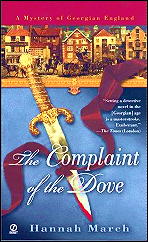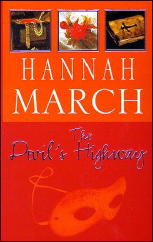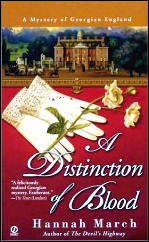Wed 17 Mar 2010
Archived Review: HANNAH MARCH – The Complaint of the Dove.
Posted by Steve under Authors , Bibliographies, Lists & Checklists , ReviewsNo Comments
HANNAH MARCH – The Complaint of the Dove. Headline,UK, hardcover & paperback, 1999. First US publication: Signet, paperback, March 2003.
As far as I’ve been able to determine, this is a First Novel, and if such it is, it’s all the more remarkable, since this is a mystery taking place in 1760s England that’s as splendid a fair-play detective novel as it is an outstanding work of historical fiction.

The hero and reluctant sleuth is Robert Fairfax, private tutor to a young, headstrong son of an ailing but wealthy father. Determining that a trip to London would widen young Matthew Hemsley’s horizon’s, Fairfax does not foresee the disaster in store: his young ward accused of murder and jailed in Newgate prison.
The early third of the tale is humorous, warm and witty, as Robert and Matthew get a rare peek behind the scenes of a London musical theatre, where singer and performer Lucy Dove is the talk of the town.
Young Matthew is instantly smitten, again not part of Fairfax’s original instruction plans, but in terms of showing him the ways of the world, then yes.
The story takes a distinct turn to the melancholy, however, when sudden death interjects itself, and Fairfax hitherto unused skills in detection are the young boy’s only hopes. He’s up to the task, however, in a very neatly plotted tale, with clues and motives galore.
Nor is the book any slouch, either, when it comes to giving the reader the authentic feeling of visiting the city of London of almost 250 years ago. Here’s how March describes a gala party to which Fairfax is invited, as his travels and deliberations grant him long glimpses into both the highs and lows of the day’s society. From page 212:
As well as telling a tough sort of coming-of-age story, March also allows Fairfax’s own mysterious past to come gradually to light, giving us a detective that we see fully realized as flawed, but one we’d most assuredly like to see more of.
PostScript: Doing some Googling on the Internet produces the following Good News. The second Robert Fairfax mystery was The Devil’s Highway (Headline, 2000), and Googling some more … apparently there are now five in the series in all. We in the US are going to have some catching up to do.
[UPDATE] 03-17-10. More information about Hannah March that I’d hadn’t found or thought to include with the earlier review. Expanded from “her” entry the Revised Crime Fiction IV, by Allen J. Hubin:
MARCH, HANNAH. Pseudonym of Tim Wilson, 1962- . Series character in all: Robert Fairfax.
* The Complaint of the Dove (n.) Headline 1999 [London; 1760]
* The Devil’s Highway (n.) Headline 1999 [London; 1761]

* A Distinction of Blood (n.) Headline 2000 [London; 1762]

* Death Be My Theme (n.) Headline 2000 [London; 1764]
* A Necessary Evil (n.) Headline 2001 [Bath; ??]
The first three were published in the US by Signet as paperback originals. Neither of the last two have been published in the US. When Fairfax’s career as a fictional detective came to close, author Tim Wilson seems to have switched to writing historical fiction without a detective, this time under the name of Jude Morgan.
Of eight books so far in the latter category, the most recent is Charlotte and Emily: A Novel of the Brontes (2010).